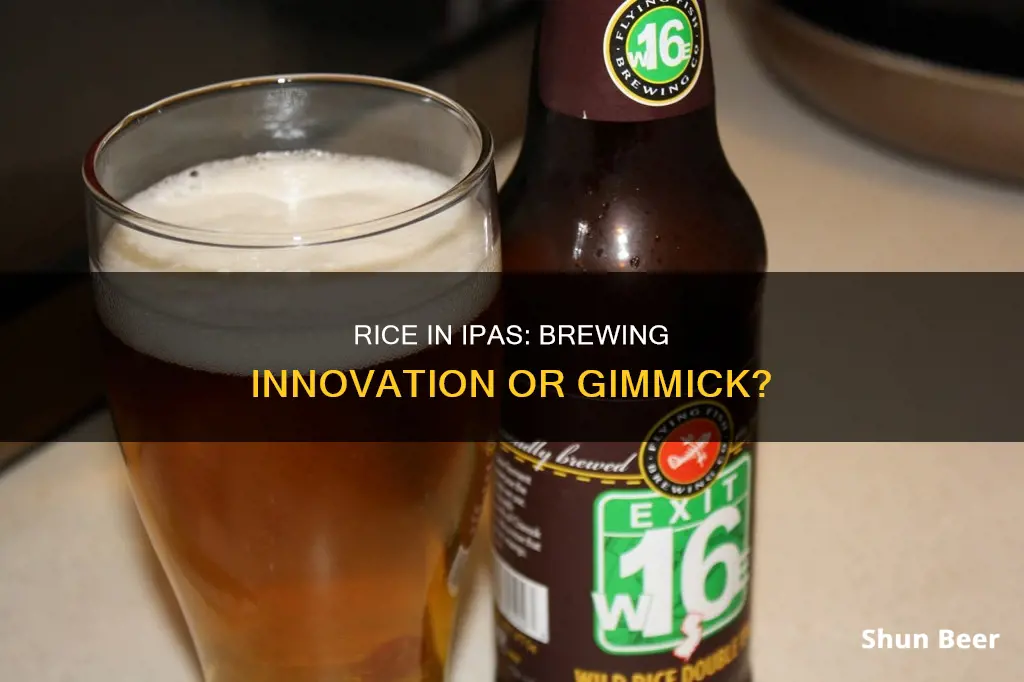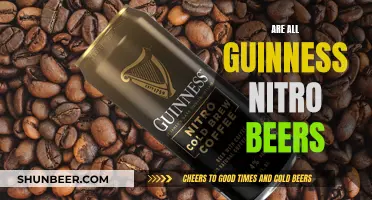
Rice is an increasingly popular ingredient in beer, with well-known brands such as Budweiser, Asahi, and Kirin using it in their brews. It is also used in craft beers, including IPAs, and can add a subtle umami taste to the drink. Brewers use whole rice, rice syrup, or rice flakes, which can enhance flavor, provide a source of sugar for fermentation, and facilitate the brewing process. Rice is also used to create gluten-free beer, which is suitable for those with celiac disease or gluten intolerance.
| Characteristics | Values |
|---|---|
| Purpose | Enhancing flavour, source of sugar for fermentation, facilitating the brewing process |
| Gluten-free | Yes, some rice beers are gluten-free |
| Antioxidant properties | Yes, rice beer contains antioxidants |
| Taste | Subtle umami taste, light, fresh, crisp, neutral |
| ABV | 3.6-6.5% |
| Nutritional advantages | Calcium, sodium, potassium, iron, phosphorous |
| Health benefits | May confer a lower risk of heart disease, medicinal properties |
| Global popularity | Gaining popularity due to health benefits and gluten-free options |
What You'll Learn

IPAs are here to stay
Rice has been used in beer for centuries, but its popularity has grown in recent times. It is a versatile ingredient, adding subtle sweetness and a crisp texture. Its neutral flavour means it can be used in a range of beers, from light lagers to fruity ales and hoppy IPAs.
Rice is an excellent adjunct, providing a high starch content for fermentation and a lower protein content than other grains, resulting in a clear, crisp beer. It is also a plentiful and cost-effective ingredient, especially in Asia, where it is the staple food.
Craft brewers are embracing rice and creating innovative new beers. For example, Chuckanut Brewing in Washington has won awards for its Asian Style Lager, and Belgium-based Bossuwé Brewing Co. received a gold medal for its "Forbidden Rice" ale.
Rice is also used in some of the world's most popular beers, including Budweiser, which has featured rice in its recipe since 1876. Other well-known rice beers include Sapporo, Kirin, and Asahi.
The use of rice in IPAs is an exciting development, providing a crisp, slightly sweet, and nutty flavour. With the growing popularity of IPAs and the desire for gluten-free and lower-calorie options, rice is an ideal ingredient.
The versatility and accessibility of rice, combined with its ability to create a crisp, tasty beer, ensures that it will continue to be a key ingredient in IPAs and other beers for years to come.
Guinness Beer's pH Mystery: Acidic or Not?
You may want to see also

Not all IPAs are bitter
IPAs, or India Pale Ales, are known for their strong hoppy character and aromatic notes. While some people enjoy the bitterness of IPAs, others may find it overwhelming. However, it's important to note that not all IPAs are created equal, and the level of bitterness can vary significantly between different brews.
The IPA style is constantly evolving, and brewers are increasingly experimenting with new techniques to reduce the perception of bitterness and bring out other flavours. For example, by using new hop varieties and adding ingredients like oats and wheat, brewers are creating juicy, fruity, and smooth IPAs that appeal to a wider range of taste preferences.
One style that has gained popularity in recent years is the New England-style or Northeast-style IPA. These beers are known for their unfiltered, hazy appearance and a focus on fragrance and aroma rather than bitterness. By adding hops later in the brewing process, brewers are able to create a beer that is less bitter but still packed with flavour.
Another option for those who want to avoid bitterness is to seek out session IPAs, which have a lower alcohol content but are still full of flavour. These beers are about as boozy as a Bud Light but offer a much more interesting drinking experience. Founders' All Day IPA and Evil Twin Citra Sunshine Slacker are great examples of session IPAs that deliver on taste without the high ABV.
Additionally, some IPAs are now being brewed with rice, which adds a subtle nutty flavour and contributes to a light and crisp character. These rice IPAs offer a unique taste experience and are also gluten-free, providing an option for those with gluten sensitivities.
So, if you're not a fan of bitter beers, don't write off IPAs completely. With the ever-expanding world of craft beer and the constant innovation in brewing, you're sure to find an IPA that suits your palate. Whether it's a juicy New England-style IPA, a smooth session IPA, or a unique rice IPA, there's an IPA out there for everyone to enjoy.
Explore the World of IPA Beers and Their Unique Taste
You may want to see also

Different types of hops in IPAs
Hops are the key ingredient that gives IPAs their distinct taste. They are flowers used as flavouring and preservatives in beer, with different types of hops imparting unique flavour profiles and characteristics. The types of hops most commonly used in IPAs originated in the USA.
One of the most popular types of hops used in IPAs is Cascade. This hop variety, first developed in the United States, is known for its strong citrus and piney aroma. Beers such as Sierra Nevada Pale Ale and Bell's Two Hearted Ale use Cascade hops.
Another popular variety is Simcoe, known for its strong pine and earthy aroma. Beers such as Dogfish Head 60 Minute IPA and Stone IPA use Simcoe hops.
Mosaic is another popular hop used in IPAs. It is known for its tropical fruit and berry aroma and is often used in American-style IPAs. Beers such as Ballast Point Sculpin IPA and Founders All Day IPA feature Mosaic hops.
Citra is also a popular choice for IPAs. With strong citrus and tropical fruit aromas, Citra is often used in American-style IPAs. Founders Centennial IPA and Sierra Nevada Torpedo Extra IPA are examples of beers that use Citra hops.
English-style IPAs typically use different hop varieties such as East Kent Goldings and Fuggle, which have more earthy and floral aromas. Fuller's IPA and Greene King IPA are examples of beers that use these English-style hops.
Other popular hops used in IPAs include Chinook, Centennial, Columbus, Galaxy, Amarillo, and Nugget.
Guinness Beer Distributors: A Global Network of Suppliers
You may want to see also

Different styles of IPAs
IPAs, or India Pale Ales, are the most popular craft beer style in America and the world. The style is broader than most people think and has many variations. Here are some of the different styles of IPAs:
British IPA
The original style of IPA, British IPAs are hoppy golden ales that use exclusively British hops like Fuggles and Goldings, resulting in a grassy, earthy, and light citrus character. They are usually around 6-7% ABV and dry.
West Coast IPA
Invented in California, West Coast IPAs take inspiration from British IPAs but use American "C" hops, such as Cascade, Citra, and Chinook, giving them a huge citrus aroma with hints of pine and a slightly dank, weed-like smell. They are less dry and more bitter than British IPAs.
East Coast IPA
A relatively new style, East Coast IPAs are similar to West Coast IPAs but use mutated, complicated British yeasts, producing lots of stone fruit, banana, and tropical notes. These beers are less bitter and cloudier than their West Coast counterparts.
Double IPA or Imperial IPA
Double IPAs, also known as Imperial IPAs, are stronger and hoppier versions of the classic IPA. They balance the sweetness of strong alcohol and lots of malt with bitter hops, resulting in a turbo-charged IPA. These beers typically have an ABV of 7% and above.
Session IPA
Session IPAs aim to deliver the high-octane flavors of an IPA with the low gravity of a session beer. They offer a big dose of hops at no more than 5% ABV, making them highly drinkable and full-flavoured.
Black IPA or Cascadian Dark Ale
Black IPAs, also known as Cascadian Dark Ales, are brewed to look like a stout but have the aroma of a West Coast IPA and a flavour that falls somewhere in between. A well-crafted Black IPA is full-bodied and clean, with a hint of roastiness and a huge hoppy finish.
New England IPA or Hazy IPA
Craft breweries in New England developed this juicier, fruitier, and hazier style of IPA. Heady Topper from The Alchemist in Vermont is widely considered the pioneer of this style. NEIPAs eliminate much of the bitterness common in West Coast IPAs and tend to be opaque, pale yellow to golden-orange in colour.
Milkshake IPA
Milkshake IPAs are a variation of the New England IPA style, brewed with milk sugar (lactose) to give them a creamy, smoothie-like quality. Fruits and other adjuncts like vanilla or marshmallow are often added to enhance the pillowy mouthfeel and impart a boozy shake sensation.
Sour IPA
Sour IPAs are a marriage of the New England IPA and the Sour Ale. They are brewed with lactobacillus, a type of yeast used in the souring process, resulting in tart, fruity, and funky flavours. Fruits, adjuncts, and sometimes barrel aging are used to experiment with flavours and processes.
Belgian IPA
Belgian IPAs are brewed with Belgian yeast and European malts, giving them a classically malty, caramelly, fruity flavour. However, they are also loaded with hops to amplify the beer's character and inject a bitter bite to round out the flavours.
Red IPA or Imperial Red Ale
Red IPAs, also known as Imperial Red Ales, are inspired by the Irish Red Ales. They showcase American hops to bring a welcome bitterness that rounds out the beer's notes of toffee, roasted barley, and citrus. These beers can range from amber to burgundy in colour.
While rice is sometimes used in IPAs, it is not a defining characteristic of the style. Rice is often used as an adjunct in brewing to supplement the sugar content of barley and wheat malt, lighten the body and colour of the beer, and add a subtle umami taste.
Guinness Beer: The Magic of Nitrogen and Carbon Dioxide
You may want to see also

The history of IPAs
India Pale Ale (IPA) is a hoppy beer style within the broader category of pale ales. The name comes from the beer's origins as an export beer shipped to India, which was under the control of the British East India Company until 1858.
The pale ales of the 18th century were lightly hopped and quite different from today's pale ales. By the mid-18th century, pale ale was brewed mostly with coke-fired malt, which produced less smoking and roasting of barley in the malting process, resulting in a paler beer. One such variety was October beer, a well-hopped brew popular among the landed gentry, brewed domestically and intended to be cellared for two years.
George Hodgson's Bow Brewery, on the Middlesex-Essex boundary, is believed to be among the first brewers to export beer to India. The brewery's proximity to the East India Docks and Hodgson's liberal credit line of 18 months made his beers popular among East India Company traders. The beer benefited from the conditions of the voyage and was highly regarded by its consumers in India.
However, the East India Company eventually grew tired of Hodgson's business practices and sought new brewing partners in Burton upon Trent, where brewers had lost their valuable export markets in Russia. The Allsopp, Bass, and Salt breweries improved upon Hodgson's recipe for hopped pale ale and took over the Indian market.
The first known recorded mention of the phrase "India Pale Ale" was in 1835 in an edition of the Liverpool Mercury. By the 1840s, IPAs had become one of England's best-selling beers. The style started being exported to other colonial countries, such as Australia and New Zealand, with many breweries dropping the 'I' in 'IPA' and simply calling them Pale Ales or Export Pales.
The popularity of IPAs in England waned by the start of the 20th century due to new styles entering the market and increased taxes on higher-gravity beers. However, the style was revived in the early craft beer revolution in America during the 1970s and 1980s, with brewers adding new styles of hops and increasing the alcohol content. This led to the various styles of IPA available today, including West Coast IPAs, East Coast IPAs, Imperial IPAs, Session IPAs, Belgian IPAs, New England IPAs, and Milkshake IPAs.
Skull IPA Beer: Registered in New York?
You may want to see also
Frequently asked questions
The IPA, or India Pale Ale, is a popular style of beer that comes in a range of styles. IPAs are known for their hoppy, fruity, and bitter flavours, and can range from low to high alcohol content.
Yes, rice is sometimes used in IPAs. While not all rice-based beers are gluten-free, some are, making them a good option for those with gluten sensitivities. Rice also adds a subtle sweetness to the beer, and its neutral flavour allows other ingredients, such as hops, to shine through.
Some popular rice-based IPAs include Michigan's Kuhnhenn Brewing Company's DRIPA, a double IPA made with American long-grain rice, and Anderson Valley Brewing Company's Black Rice Ale, a nut brown ale brewed with black rice.







